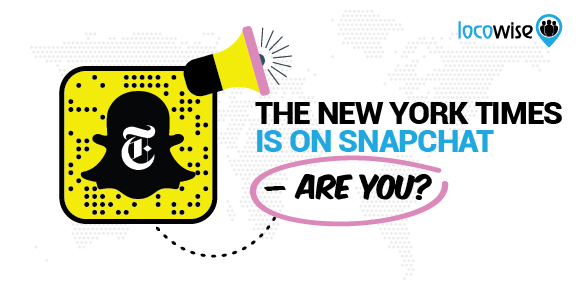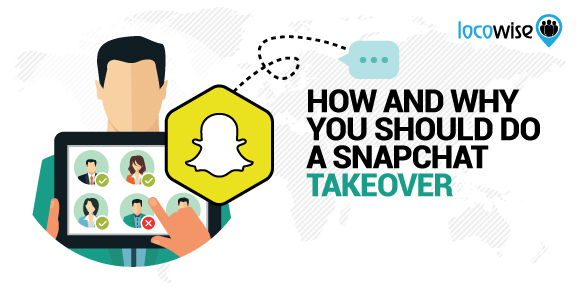The New York Times is On Snapchat – Are You?
Catherine Hayden posted on 28 February 2017
The New York Times has just announced a partnership with Snapchat.
It’s parent company, Snap Inc, recently filed documents for a stock offering that could be worth $30 billion and, around the same time, released “Spectacles”, sought after sunglasses that record video clips to be uploaded directly to social media.
What has made Snapchat so successful and what, if anything, should this mean for your digital marketing strategy?

What is Snapchat?
Snapchat is essentially a video- and image-messaging app that launched in 2011. What makes it unique is that all photos and videos sent from one Snapchat user to the next disappear forever in a short space of time (of course, you can take screen shots of them if you’d like to). You can also save your own “snaps” before sending them to your friends or sharing them.
Because the app feels so ephemeral, it offers something new to users: a sense of urgency in not wanting to miss a story, and — more importantly — it gave people a sense of anonymity that allowed them to share intimate snippets of their lives and daily experiences more freely than ever before.
In late 2013, Snapchat allowed people to create “stories”, essentially a collection of videos and photos that could only be viewed for 24 hours. Snapchat’s filters allow users to self-edit their video or images before sharing them. Some of the most popular filters include the self-explanatory “soft skin filter”, the “bug eye face”, and the “cute puppy face”. You can see them here.

In 2015, Snapchat launched Discover, an extension of their stories feature. Discover allows users to view content from brands, publishers, and Snapchat’s in-house editorial team. This content, a compilation of branded images, video, editorial (and advertising) is uploaded daily and, true to Snapchat’s original MO, is available for only 24 hours.
New Tech For The Times
The New York Times began experimenting with Snapchat close to the launch of Discover in what may seem to be an unlikely partnership. The platform is associated with a young audience who wouldn’t typically consume the “Gray Lady” with its distinctive serious typeface and hard news angle.
However, this daily isn’t the only media source interested in Snapchat’s audience. Snapchat’s Discover currently partners with more than 30 channels worldwide, including BuzzFeed, CNN, Mashable, Comedy Central, NatGeo, and The Economist. All are interested in tapping into a new advertising stream from a growing young audience.
The New York Times’ Farhad Manjoo says: “Snap, which is based far outside the Silicon Valley bubble, in the Venice neighborhood of Los Angeles, is pushing radically new ideas about how humans should interact with computers. It is pioneering a model of social networking that feels more intimate and authentic than the Facebook-led ideas that now dominate the online world. Snap’s software and hardware designs, as well as its marketing strategies, are more daring than much of what we’ve seen from tech giants, including Apple.”
An endless sea of pink hats and signs: Follow @nytimes on Snapchat for look at the Women's March on Washington https://t.co/8jbiyfNLg4 pic.twitter.com/CGMJGI26ml
— The New York Times (@nytimes) January 21, 2017
Kinsey Wilson, EVP of product and technology for the New York Times Co, explained that Snapchat is “an ideal place” to reach younger consumers of media. “At the end of the day, our goal is to make sure our journalism reaches the widest possible audience.”
The Numbers
| Millennials dominate Snapchat, with the average user age being 13-34 |
| 60% of this demographic in the US uses the app |
| 77% of US college students use it daily |
| Snapchat has a current annual growth rate of about 50% |
| Snapchat has 150 million people using the service each day, making the four-year-old app more popular than Twitter |
Accounts You Want To Follow
To get a good understanding of how Snapchat works, there are a few accounts you’d want to follow. These brands, organizations, and people, snap well.
| Apple Music famously avoided social media until they launched their music streaming service and Snapchat provides the perfect audience base. |
| Gary Vaynerchuk, known for his passion and his inspiring approach to social media, is true to form on Snapchat. Vaynerchuk’s account is known for frequent short spurts of advice. |
| Taco Bell set a Snapchat record when it ran a campaign to celebrate Cinco de Mayo last year. They launched a sponsored lens campaign that turned fans’ heads into giant taco shells. The campaign, live for only one day, generated 224 million views. |
| Los Angeles County Museum of Art has more than 120,000 works from all periods of history and its account is an interesting, meme-filled, example of what happens when internet culture meets art. |
Five Reasons To Snap
1. Reach a younger audience
The social media landscape is changing demographically and Facebook, arguably the most popular and successful social media platform for paid advertising spend, is increasingly home to an older audience. The Pew Research Center found in its “Social Media Update 2016” that around 62% of online adults in the US now use Facebook, compared to 48% in 2015. By comparison, roughly six out of 10 adults in the US aged 18-29 use Instagram. Roughly half of Snapchat users are 18-29.
2. More one-on-one engagement
Speaking to someone on a one-to-one basis is powerful. Snapchat makes it easier for you to send content directly to individual followers, as long as they are following you. This allows you such close access to your consumer base that you can build a relationship that feels very “real” to the user, cultivating finely tuned consumer loyalty.
3. Be the “cool” brand
Not too long ago Snap Inc turned down a $3 billion acquisition offer from Facebook. It’s widely believed in tech circles that Facebook was so interested in the platform because it offered something Facebook had lost – a sense of being “cool”. Facebook has since turned its attention to Instagram, which now offers many features that are similar to those of Snapchat’s – like stories. Instagram, however, doesn’t offer what has been called Snapchat’s “auto-delete” function. This is used by 24% of US smartphone owners. Instagram also doesn’t have Snapchat’s quirky filters and easy-to-use editing tools.

4. Get there first
If the Snapchat audience is your demographic, you may want to hit the ground running like the New York Times has and start using it sooner rather than later. Taking advantage of Snapchat’s image could help your brand establish a new audience, grow an existing target group, and subtly rebrand to align itself with a new generation of media consumers.
5. Go bold
Social media analysts have been speculating about Snapchat’s future with little consensus since its inception. Adopting such a new platform may come with uncertainties, but Facebook had faith in the brand and Snap Inc certainly does. The $30 billion stock offering recently signed by Snapchat’s parent company could be indicative of big things to come.
The Downside
Social media is about measurables. When your brand invests in a campaign, you should know exactly who it is reaching and then use a good analytics engine to pull data from the campaign that can accurately measure its success.
This marketing insight is more streamlined than it has ever been, and the data garnered from a campaign can be represented with minute clarity. Snapchat analytics are known for being unwieldy, as much has to be done manually in terms of representing them. The platform isn’t yet freely available on metrics tools, which is a big limiting factor.
In addition, while there is much scope for creativity when marketing on such a new platform, there is also room for failure.
It’s Your Call
So should you start using Snapchat now? Yes, if it makes sense for your brand. If not, as with any other platform, the answer is: “no”.
Here are a few things to ask yourself before you decide:
| 1. | Is my demographic on Snapchat now or will they soon be? |
| 2. | Is the timing right for my brand, service, and social media team? |
| 3. | Does Snapchat’s tone match my brand’s tone or intended tone? |
| 4. | Can I identify suitable local and international influencers to build relationships with? |
| 5. | Do I have the financial and human resources to invest in a time-consuming new medium? |
| 6. | Am I already excelling on the platforms that are my main focus? |
| 7. | How worried am I about the ease of interpreting metrics? |
| 7. | Do I have a strategy when it comes to Snapchat’s return on investment? |
| 7. | Am I ready and willing to take a risk and try it out? |
| 7. | Have I downloaded it and used it myself? |





